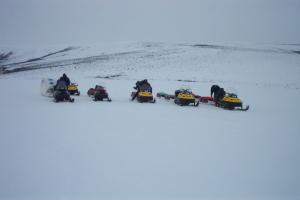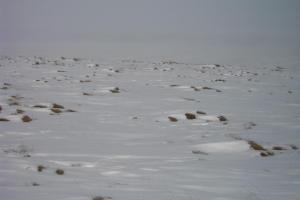30 March, 2002
Last day of SWEEEE talk!!!!! Why do we measure
SWE's? Why are they important??
If we know the density of snow, then we also can
know the thermal conductivity of the snow. This
means how insulative the snow actually is. Snow
can be thought of as a huge, warm blanket that
warms everything that lies underneath. The
amount of snow can actually warm the vegetation
causing it to grow taller. This is why we are
seeing the effect that larger shrubs have on the
ecosystem. The larger the shrubs, the more snow
is trapped hence the ground is warmed. Since the
ground is warmed, the vegetation can continue to
grow larger. If the vegetation continues to grow
larger, there is more brown or dark colors on the
land. Dark colors absorb light or radiation from
the sun, whereas, light colors reflect radiation.
All of you have experienced this when you have
worn a black coat on a warm, hot, sunny, NC day.
The black coat is absorbing the sun's radiation
causing you to be warm. The same phenomenon
occurs with the snow and vegetation. The white
snow reflects the solar rays sending it back into
the atmosphere. The dark colors of the
vegetation absorbs the sun's rays trapping this
heat in the Earth's atmosphere. So, if the
vegetation is growing taller in the Arctic this
could be changing the overall climate of the
Earth.
The snow in the shrubs also affects the microbial
activity within the soil. This means the
bacteria activity occurring in the soil. There
are countless numbers of bacteria in the soil
that are undergoing activities that affect the
entire ecosystem. The snow in the shrubs
insulates the ground causing the ground to be
warmer. Since the ground is warmer, the
microbial activity will be higher. In the
tundra, there is less snow causing the ground to
be colder causing less microbial activity to
occur. Since the theory is that the Arctic is
warming and there is a change in vegetation
occurring, the shrubs are getting bigger. If the
shrubs are getting bigger, than there is more
microbial activity occurring in the soil. This
microbial activity releases carbon dioxide into
the atmosphere. This release of carbon dioxide
could affect the entire atmospheric gas
components. If there is a significant amount of
carbon dioxide being released into the
atmosphere, it could be related to the greenhouse
effect and global warming.
Another application of density is a biological
importance. The density of snow can affect the
harsh Arctic animal life. There is a fierce,
wild predator to prey relationship that occurs in
the cold land. If the density of the snow is
low, the snowpack will be soft meaning there is
less water molecules in that given space. If the
density of the snow is high, the snowpack will be
hard because the molecules are tightly packed
together. Caribou and moose are two large
animals that travel on this snow. They are also
hunted by predators such as wolves and
wolverines. If the density of the snowpack is
low, the caribou and moose will have a hard time
walking across the snowpack. They will stumble
and fall in the masses of snow. This makes for a
much easier kill for the wolf and wolverine. They
are able to catch up and attack the large animals
weakened by the snowpack. Biologists are able to
determine if the caribou and moose populations
will be altered greatly in a year due to the
snowpack.
See, The SWEEEEEE's a very important and useful
scientific measurement!!!!!
WHERE IS MRS. CHEUVRONT????? LET'S PLOT!!!!
Longitude: 65.93907 North
Latitude: 161.29051 West
High Temp: -6 degrees Celsius
Low Temp : -15 degrees Celsius
Camp was broken and we traveled in our caravan of
snowmachines onto the tundra. The morning was
blessed with a fox traveling fast across the
tundra. It seemed to be hurrying about it's
daily life as we were with ours. The clouds that
traveled in during the night brought warmth and a
light dusting of snow. We performed two tundra
sites and traveled on to Buckland. Tonight we
camp close to Buckland.
=====
April Cheuvront
7133 Rhododendron Drive
Newland, NC 28657
(828) 439-5737
../tea_cheuvrontfrontpage.html
aprilcheuv@yahoo.com

Our 6 snowmachines with all of our sleds and equipment. We travel approximately 20 miles a day and perform multiple snow measurements. ===== April Cheuvront 7133 Rhododendron Drive Newland, NC 28657 (828) 439-5737 ../tea_cheuvrontfrontpage.html aprilcheuv@yahoo.com

The snow forms drifts against the tussocks of the tundra.
Contact the TEA in the field at
.
If you cannot connect through your browser, copy the
TEA's e-mail address in the "To:" line of
your favorite e-mail package.
|
